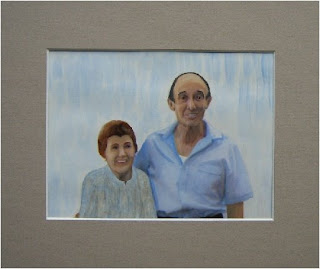When you’re decorating a room you will often replace the curtains, cushions and other soft furnishings. You can use some of the new fabrics to create your own colour (and pattern) matched art.
What size?Choose your stretched canvas so that it is the size you want for the completed picture. This choice will probably depend on where you intend to display the canvas.
Then you have a couple of options...1. You can stretch the fabric over the canvas, and staple it on at the back. Seal the fabric with a clear acrylic medium and leave to dry. You now have a completed piece for displaying.
When you’re using a medium to heavy weight fabric (cotton works best) you can fix it over just the stretchers. (In the same way as a stretched canvas, but without the canvas)
If you’re good at woodwork you could make up a wooden frame to stretch the fabric over.
2. Or once you get to this stage you can prime the fabric with a matt acrylic medium and once it is dry you can add some paint to enhance the look and make a totally original piece of art.
If you’re using a fabric with a pattern you will need to use transparent or thinned colours if you don’t want to cover up the original fabric pattern.
Use your imaginationThis is an interesting way to make matching artwork when you are decorating.
You can use some of the leftover fabric and add additional colours or patterns. This way the artwork will match those colours and patterns used in the room without being exactly the same.
Top Tip Be sure to buy some extra fabric it you want to try this idea.
You could add some metallic paints to decorate the fabric, or paint some thicker paint onto certain areas to make it more three dimensional.
Fabric weights
If you wanted to do this with a thinner fabric you can glue the fabric onto a stretched canvas. However if the fabric is strong enough you can just staple it onto a stretched canvas instead. Just stretch the fabric and staple it onto the back of the frame for the best result.
To do this start in the middle of the opposing sides and work out towards the corners. I find it best to do just the middle section of the top and bottom sides, then the middle section of the left and right sides before getting all the way to the corners. It helps to get the fabric smooth and flat.
If you have trouble getting a tidy result you can always remove the staples and start again.
As I mentioned already if you’re using a strong cotton type fabric you have the option of fixing it to just the stretchers (without the canvas). However I like to use a stretched canvas as I think that having the canvas underneath the fabric makes the final piece stronger and it’s easier to paint onto as well.
You could sewIf you wanted to use a few different fabrics you could always sew them together to make up a fabric section big enough to cover your stretched canvas. And then carry on from there.
You can really use your ingenuity to produce something wonderful.
Other additionsThis idea works really well with patterned fabrics. You can just pick out some of the pattern to enhance, either with additional paints or adding some of the unusual acrylic mediums. Some of these acrylic mediums have things added to them (like small beads) to produce an interesting look.
Acrylic paint also acts as an adhesive so you could add small objects to the wet paint.
The Best Top Tip
Be sure to staple the fabric onto the back of the stretched canvas so that (when the canvas is hung) the stapled area will be facing the wall. Spend a bit of time getting the corners looking neat and tidy too. This means that you can hang the artwork without a frame and it will look great.
This is a modern look and (with no need to pay for framing) it will save you some money too.
Making your own original artwork can be easier than you think.






















